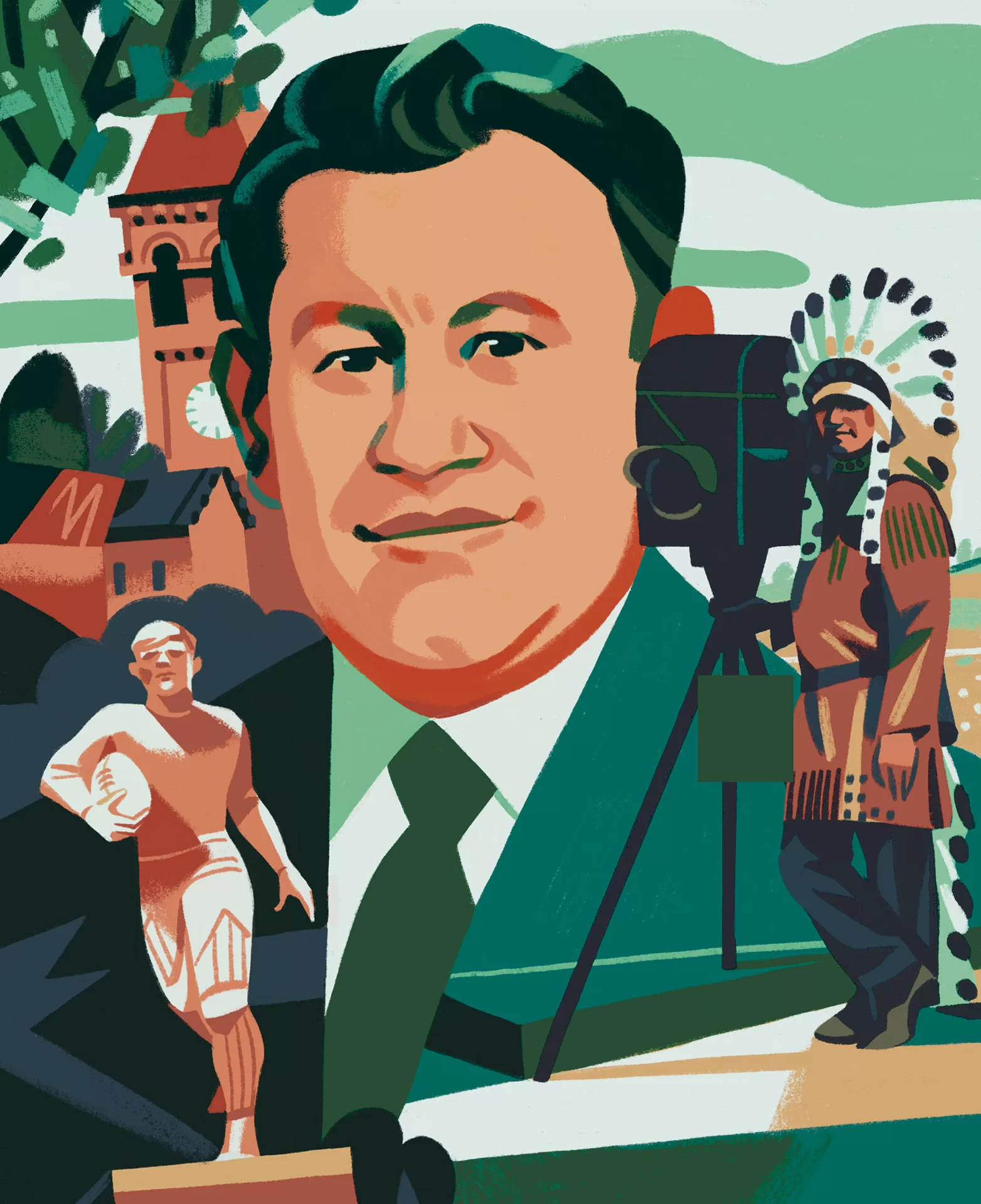The world’s greatest athlete
United States, early 1900s: a non-citizen Native American becomes an exemplary figure of extraordinary physical and mental balance. His name is Jim Thorpe
by Nicola Feninno
Illustrations by Marta Signori
Jim Thorpe is a small borough of approximately 4,500 people in Pennsylvania. The Lehigh River splits it in two, creating two distinct checkerboard street patterns on either bank. From the bridge that spans the river, visitors can walk a mile along North Street and Ninth Street to reach the Jim Thorpe Memorial Hall. The inscription on the front of the striking, majestic marble monument reads, “Sir, you are the greatest athlete in the world.”
As explained just below it, the words were uttered by King Gustav of Sweden during the award ceremony at the 1912 Olympic Games in Stockholm, directed toward Jim Thorpe, whose remains now peacefully rest within the monument. Records indicate that Thorpe, almost speechless with modesty, responded, “Thank you,” or perhaps, “Thanks, King.”
Sport is many things at once, but it always harbors a playful nature, a particular childlike essence. Like wandering here and there until you forget your destination, lose your way home, and give up your sense of duty in the name of the (more or less innocent) pleasure of discovery. Like Odysseus, Jim Thorpe embodied this multifaceted ingenuity.
There has probably never been a more versatile sporting talent than Jim Thorpe. In the 1912 Olympics, he emerged as a champion in both the classic pentathlon (broad jump, javelin, discus, 200-meter dash, 1500-meter race) and the decathlon (100 meters dash, running broad jump, shot put, running high jump, 110-meter hurdles, 400-meter run, discus, javelin, pole vault, 1500-meter run).
His versatility made him one of the most important players in the history of American football. He also played in Major League Baseball, including with the glorious New York Giants; the football championship was played in the fall-winter, and the baseball championship in the spring-summer, so he was able to play in both.
In 1950, an Associated Press poll voted Jim Thorpe “the greatest athlete of the first half of the 20th century” and in 1999 placed him third on its list of the top athletes of the entire century, trailing only Babe Ruth and Michael Jordan.
“I never specialized; I tried everything,” Thorpe declared, summing up his approach to sports and to his life in general, which amounted to several lives combined.
He was reportedly born in May 1887, but his birth certificate has never been found, and his tombstone bears the date 1888. He grew up on a Meskwaki Native American reservation, but both his mother and father were of mixed-race ancestry. In 1953, he succumbed to a heart attack, the third in his life. His childhood was marked by the tragic loss of his twin brother at the age of eight.

Illustrations by Marta Signori
Thorpe attended the Carlisle Indian School, an institution that aimed, with at least paternalistic intentions, to assimilate Native American youth into mainstream American culture. It was here that Thorpe began to play football. When he became an Olympic champion, he was 24 years old (or 25, depending on the interpretation of his birthdate): the American team had reached Sweden after a fourteen-day transatlantic voyage.
Despite his exceptional performance, the following year he was stripped of his two gold medals for alleged “professionalism.” According to the strict rules set out by the president of the International Olympic Committee, Baron de Coubertin, only amateur athletes, people who earned their living in other ways or who simply did not need to earn a living, were eligible to participate in the Games.
Three years earlier, Thorpe had been paid to play in a few minor league baseball games, essentially as summer jobs. While this was a common practice, most athletes had the good sense to sign contracts under fake names. Ulysses had called himself “Nobody” to escape the wrath of Polyphemus. Thorpe, however, used his real name — a name that, honestly, is unclear (James Francis, it seems, or Jacobus Franciscus, as on his baptismal certificate). His victories were not reinstated in the Olympic records until 2022.
In 1929, amidst the Great Depression, Thorpe returned to Los Angeles and worked as a judge in a dance marathon (a contest to dance as long as possible, without leaning against walls or falling asleep, to win a few dollars). By then, he was 41 (or 42) years old, his athletic career was over, and he was struggling to make ends meet. In 1930, he got a job as a truck painter and gas station attendant in the Santa Monica Bay area.
He then worked as a car salesman, construction worker, photo developer, and bouncer. He even ventured into the glittering world of movies, appearing as an extra in more than seventy films, usually portraying Native American characters. In some cases, he played the role of himself, but never for more than a few seconds. Despite his efforts, his financial situation remained precarious.

Illustrations by Marta Signori
At the age of 52, he got a job in Detroit as a supervisor at the Ford plant, where jeeps were rapidly being produced to be sent to the Army on the European front. With the end of the war, America was poised to become the political and economic powerhouse we know today.
In 1951, during a radio broadcast, sportscaster Bill Stern drew attention to Thorpe’s dire circumstances (his name was still very legendary), revealing his poverty, ill health, and loneliness. Stern urged listeners to send donations to Thorpe, even providing his mailing address on the air.
“I never specialized,” Thorpe once remarked, an attitude typical of geniuses and children, and that remains one of the most challenging aspects for artificial intelligence to replicate.
In 1951, just a few months later, Warner Bros. released a biographical film about Jim Thorpe’s life. However, Thorpe himself did not profit from the movie, having sold the film rights to Metro-Goldwin-Mayer in 1929 for a paltry $1,500. But he still did get $10,000 for a consulting role. Months of work, trying to put all the pieces of his past together, as if that life, those lives, were not his own. It must have felt to him like trying to catch his own shadow.
“He simply ran wild, while the cadets tried in vain to stop his progress. It was like trying to clutch a shadow,” observed a New York Times correspondent after watching the newly crowned Olympic champion overthrow the U.S. Army football team in 1912.
Grabbing a Shadow is the title of Tommaso Giagni’s well-written biography of Jim Thorpe (recently published by Minimum Fax): this article is indebted to him.
Thorpe’s Meskwaki name is Wa-Tho-Huk, meaning “bright path.” He had eight children, one of whom passed away at the age of three; the others don’t exactly portray him as an exemplary father. He married three times. His third wife, Patricia Askew, determined his final resting place. She reckoned that after his death, the champion would draw a surge of celebrations, authorities, visitors, and therefore money.
And she also sought upfront compensation for herself. After nearly a year and multiple unsuccessful attempts, she struck a deal with the borough of Mauch Chunk, Pennsylvania: actually, two distinct towns, Mauch Chunk, and East Mauch Chunk, separated by the Lehigh River.
Its inhabitants had experienced a fleeting period of economic prosperity in previous decades, thanks to the coal industry, but in the ’50s they were in the throes of a crisis. The burial site of the world’s greatest athlete was seen as an opportunity to boost tourism. Jim Thorpe had never been to this town before. In all likelihood, he had never even heard of it.
In 1954, Mauch Chunk and East Mauch Chunk merged to become Jim Thorpe, Pennsylvania.



 in Italy
in Italy